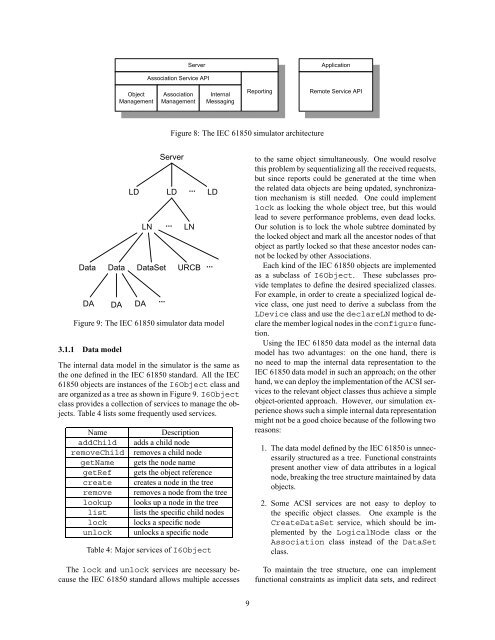Understanding and Simulating the IEC 61850 Standard - CiteSeerX
Understanding and Simulating the IEC 61850 Standard - CiteSeerX
Understanding and Simulating the IEC 61850 Standard - CiteSeerX
Create successful ePaper yourself
Turn your PDF publications into a flip-book with our unique Google optimized e-Paper software.
Server<br />
Application<br />
Association Service API<br />
Object<br />
Management<br />
Association<br />
Management<br />
Internal<br />
Messaging<br />
Reporting<br />
Remote Service API<br />
Figure 8: The <strong>IEC</strong> <strong>61850</strong> simulator architecture<br />
LD<br />
LN<br />
Server<br />
Data Data DataSet URCB<br />
DA<br />
DA<br />
DA<br />
...<br />
LD<br />
...<br />
...<br />
LN<br />
LD<br />
Figure 9: The <strong>IEC</strong> <strong>61850</strong> simulator data model<br />
3.1.1 Data model<br />
The internal data model in <strong>the</strong> simulator is <strong>the</strong> same as<br />
<strong>the</strong> one defined in <strong>the</strong> <strong>IEC</strong> <strong>61850</strong> st<strong>and</strong>ard. All <strong>the</strong> <strong>IEC</strong><br />
<strong>61850</strong> objects are instances of <strong>the</strong> I6Object class <strong>and</strong><br />
are organized as a tree as shown in Figure 9. I6Object<br />
class provides a collection of services to manage <strong>the</strong> objects.<br />
Table 4 lists some frequently used services.<br />
Name<br />
addChild<br />
removeChild<br />
getName<br />
getRef<br />
create<br />
remove<br />
lookup<br />
list<br />
lock<br />
unlock<br />
...<br />
Description<br />
adds a child node<br />
removes a child node<br />
gets <strong>the</strong> node name<br />
gets <strong>the</strong> object reference<br />
creates a node in <strong>the</strong> tree<br />
removes a node from <strong>the</strong> tree<br />
looks up a node in <strong>the</strong> tree<br />
lists <strong>the</strong> specific child nodes<br />
locks a specific node<br />
unlocks a specific node<br />
Table 4: Major services of I6Object<br />
The lock <strong>and</strong> unlock services are necessary because<br />
<strong>the</strong> <strong>IEC</strong> <strong>61850</strong> st<strong>and</strong>ard allows multiple accesses<br />
to <strong>the</strong> same object simultaneously. One would resolve<br />
this problem by sequentializing all <strong>the</strong> received requests,<br />
but since reports could be generated at <strong>the</strong> time when<br />
<strong>the</strong> related data objects are being updated, synchronization<br />
mechanism is still needed. One could implement<br />
lock as locking <strong>the</strong> whole object tree, but this would<br />
lead to severe performance problems, even dead locks.<br />
Our solution is to lock <strong>the</strong> whole subtree dominated by<br />
<strong>the</strong> locked object <strong>and</strong> mark all <strong>the</strong> ancestor nodes of that<br />
object as partly locked so that <strong>the</strong>se ancestor nodes cannot<br />
be locked by o<strong>the</strong>r Associations.<br />
Each kind of <strong>the</strong> <strong>IEC</strong> <strong>61850</strong> objects are implemented<br />
as a subclass of I6Object. These subclasses provide<br />
templates to define <strong>the</strong> desired specialized classes.<br />
For example, in order to create a specialized logical device<br />
class, one just need to derive a subclass from <strong>the</strong><br />
LDevice class <strong>and</strong> use <strong>the</strong> declareLN method to declare<br />
<strong>the</strong> member logical nodes in <strong>the</strong> configure function.<br />
Using <strong>the</strong> <strong>IEC</strong> <strong>61850</strong> data model as <strong>the</strong> internal data<br />
model has two advantages: on <strong>the</strong> one h<strong>and</strong>, <strong>the</strong>re is<br />
no need to map <strong>the</strong> internal data representation to <strong>the</strong><br />
<strong>IEC</strong> <strong>61850</strong> data model in such an approach; on <strong>the</strong> o<strong>the</strong>r<br />
h<strong>and</strong>, we can deploy <strong>the</strong> implementation of <strong>the</strong> ACSI services<br />
to <strong>the</strong> relevant object classes thus achieve a simple<br />
object-oriented approach. However, our simulation experience<br />
shows such a simple internal data representation<br />
might not be a good choice because of <strong>the</strong> following two<br />
reasons:<br />
1. The data model defined by <strong>the</strong> <strong>IEC</strong> <strong>61850</strong> is unnecessarily<br />
structured as a tree. Functional constraints<br />
present ano<strong>the</strong>r view of data attributes in a logical<br />
node, breaking <strong>the</strong> tree structure maintained by data<br />
objects.<br />
2. Some ACSI services are not easy to deploy to<br />
<strong>the</strong> specific object classes. One example is <strong>the</strong><br />
CreateDataSet service, which should be implemented<br />
by <strong>the</strong> LogicalNode class or <strong>the</strong><br />
Association class instead of <strong>the</strong> DataSet<br />
class.<br />
To maintain <strong>the</strong> tree structure, one can implement<br />
functional constraints as implicit data sets, <strong>and</strong> redirect<br />
9
















